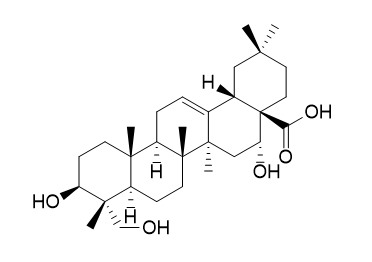Caulophyllogenin
Caulophyllogenin in the inhibition of pro-inflammatory cytokine secretion, including IL-12 p40, IL-6, and TNF-α, and for prevention and treatment of inflammatory diseases.
Inquire / Order:
manager@chemfaces.com
Technical Inquiries:
service@chemfaces.com
Tel:
+86-27-84237783
Fax:
+86-27-84254680
Address:
1 Building, No. 83, CheCheng Rd., Wuhan Economic and Technological Development Zone, Wuhan, Hubei 430056, PRC
Providing storage is as stated on the product vial and the vial is kept tightly sealed, the product can be stored for up to
24 months(2-8C).
Wherever possible, you should prepare and use solutions on the same day. However, if you need to make up stock solutions in advance, we recommend that you store the solution as aliquots in tightly sealed vials at -20C. Generally, these will be useable for up to two weeks. Before use, and prior to opening the vial we recommend that you allow your product to equilibrate to room temperature for at least 1 hour.
Need more advice on solubility, usage and handling? Please email to: service@chemfaces.com
The packaging of the product may have turned upside down during transportation, resulting in the natural compounds adhering to the neck or cap of the vial. take the vial out of its packaging and gently shake to let the compounds fall to the bottom of the vial. for liquid products, centrifuge at 200-500 RPM to gather the liquid at the bottom of the vial. try to avoid loss or contamination during handling.
Biol Pharm Bull.2017, 40(6):797-806
Buildings2023, 13(5), 1112.
Research Square2021, 10.21203.
Biosci Biotechnol Biochem.2021, 85(10):2153-2160.
PLoS One.2021, 16(6):e0248479.
Appl. Sci.2022, 12(17), 8646.
Korean Herb. Med. Inf.2021, 9(2):231-239.
Molecules 2021, 26(4),1092.
Food Chem.2024, 456:140044.
Malaysian Journal of Analytical Sciences2022, 26(2):360-369.
Related and Featured Products
Arch Pharm Res. 2013 Mar;36(3):327-34.
Inhibitory effects of oleanane-type triterpenes and saponins from the stem bark of Kalopanax pictus on LPS-stimulated pro-inflammatory cytokine production in bone marrow-derived dendritic cells.[Reference:
WebLink]
Kalopanax pictus (Araliaceae) is a deciduous tree distributed in Korea, Japan, and China. The stem bark of K. pictus has been functionally used as a traditional crude drug for the treatment of various inflammatory diseases.
METHODS AND RESULTS:
In the present study, we describe the inhibitory effects of oleanane-type triterpenes and saponins isolated from the stem bark of K. pictus on production of pro-inflammatory cytokines in LPS-stimulated bone marrow-derived dendritic cells. Of the compounds tested, 16,23,29-trihydroxy-3-oxo-olean-12-en-28-oic acid (1), 4,23,29-trihydroxy-3,4-seco-olean-12-en-3-oate-28-oic acid (2), 3β,6β,23-trihydroxyolean-12-en-28-oic acid 28-O-β-D-glucopyranoside (3), nipponogenin E (6), 3β,6β,23-trihydroxyolean-12-en-28-oic acid (7), and Caulophyllogenin (19) significantly inhibited the production of IL-12 p40 and IL-6 with IC50 values ranging from 3.3 to 9.1 μM. Compounds 2, 3, 7, and 19 significantly suppressed the secretion of TNF-α with IC50 ranging from 8.8 to 20.0 μM.
CONCLUSIONS:
These data provide scientific support for the use of K. pictus stem bark and its triterpene and saponin components in the inhibition of pro-inflammatory cytokine secretion, including IL-12 p40, IL-6, and TNF-α, and for prevention and treatment of inflammatory diseases.
J Agric Food Chem. 2011 Jun 8;59(11):6142-9.
Triterpenoid glycosides from the leaves of two cultivars of Medicago polymorpha L.[Pubmed:
21526796]
The saponin composition of leaves from the Medicago polymorpha cultivars 'Santiago' and 'Anglona' belonging to the botanical varieties brevispina and vulgaris, respectively, was investigated by a combination of chromatographic, spectroscopic, and spectrometric techniques.
METHODS AND RESULTS:
Several compounds were detected and quantitated by HPLC analysis using the external standard method. Twelve triterpene saponins (1-12) were purified by reverse-phase chromatography and their structures elucidated by spectroscopic (1D and 2D NMR, ESI-MS/MS) and chemical methods. They were identified as glycosides of echinocystic acid, hederagenin, Caulophyllogenin, bayogenin, and soyasapogenol B. Two of them (2, 10) were previously reported in M. polymorpha; five of them (4, 6, 7, 9, 12) were already identified in other Medicago species; and three of them (1, 8, 11) were found in other plant genera. The two saponins identified as 3-O-α-L-arabinopyranosyl-28-O-[β-D-glucopyranosyl(1→6)β-D-glucopyranoside] echinocystic acid (3) and 3-O-α-L-arabinopyranosyl-28-O-β-D-glucopyranoside echinocystic acid (5) are newly identified natural compounds.
CONCLUSIONS:
The presence of echinocystic acid is reported here for the first time in the genus Medicago. Saponins from the cultivar 'Anglona' were characterized by a higher amount of echinocystic acid glycosydes, whereas saponins from the cultivar 'Santiago' were characterized by a higher amount of hederagenin glycosydes.



